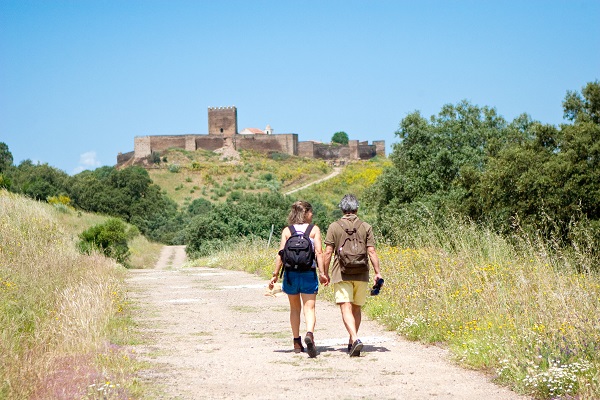Want to hear a good ghost story? Or a fireside tale of creatures and murder? In the vast Alentejo region of Portugal there are many, with ghosts of its Arab, Roman and prehistoric past. On top of that, we have the Reconquista, wars with Spain, the French invasions, and a few millennia of history.
Haunted Castles
Big, ruined and majestic — because it is the flattest part of Portugal, the Alentejo tended to be the direct route for an invasion on the way to Lisbon. Which town has more miles of walls per inhabitant in Portugal? Elvas - which is on a straight shot to Lisbon. And, if you seek imposing yet battle-worn walls, the place to start is Elvas, right on the frontier. It was a vital garrison border town, in fact its fortifications are on the list of UNESCO World Heritage Sites. Portugal’s first king took it from the Arabs in 1166 - by then Elvas was retaken and went back and forth until a final victory by Portuguese forces in 1226. As hostilities with Spain increased, so did the walls. On the medieval walls were added seven bastions and two forts. A good addition, as the Spanish put sieges to Elvas in 1659, 1711, and 1801. The city repulsed each attack, until 1808 when a French/Spanish army took the city. They say that on the walls, still intact and proud, on a moonlit night, you can still see the figure of a sentinel looking east — ready to defend the kingdom of Portugal.
Noudar is a ghost town, and it is lovely. The castle of Noudar stands alone, right on the border with Spain, 902 feet above the meeting of the Rio Ardila and the Ribeira da Múrtega. Isolation, war and time led this town to be abandoned by the 19th century. The castle still guards over the ruined village of Noudar, crowned by an intact keep tower that rises 57 feet. The town was rebuilt by a young Portugal in the 12th century - a castle built to protect the frontier. But it was soon seized by Castile, and then won back by Portugal in 1295. And with every war or conflict, Noudar was attacked. The castle was rebuilt but the 400 souls who lived there suffered successive attacks in the 16th, 17th and 18th centuries-leading it to be abandoned, with most people moving to the bigger town of Barrancos to the South. But as to the ghost, it is said that under the Castle of Noudar there lived a sad Moor who walked in the shade of the ash trees along the Rivers Ardila and Múrtega, but at the slightest suspicious sign it turns into a snake and disappears. Today it is a lovely but isolated drive or hike to the castle, and in its silence, there is a feeling of loss — and solitude as this once violent place is now at peace with nature.
The marble castle of Estremoz has a long and fascinating history. Great kings, queens and soldiers lived here. Built in its modern context by king D. Dinis, it was here that the Sainted Queen Isabel died. And it would later be the headquarters of the Sainted Constable Nuno Álvares Pereira. But beyond life, death and war — one of the darkest chapters in Portuguese history took place here in the 19th century, a massacre that is not mentioned as you tour it today. The Liberal Wars, also called the Portuguese Civil War, were fought between liberal constitutionalists and conservative absolutists over royal succession. It dragged on from 1828 to 1834. Towards the end of the war, absolutist forces held Estremoz, and imprisoned some 39 liberal supporters. As the end neared, the 39 men were murdered by the retreating absolutist forces. The room where it happened is still there, the feeling is dark — and the crime is not forgotten by the white marble walls.


Haunted Battlefields
There are many fields of battle in the Alentejo dating back to the ancient Celts and Carthaginians - but one field, oft forgotten, saw a battle so fierce that it not only secured independence for Portugal, it made a hero — who would become a saint.
Just outside of the walled town of Fronteira, not far from Spain, is the field of Atoleiros - where an interpretive center explains and documents the battle fought here on April 6, 1384. Castile, a pre-Spanish nation, sent a major force to probe Portugal’s defenses as the neighboring nation sought to claim the Portuguese crown. A young knight named Nuno Álvares Pereira was sent to secure the defenses against a Castilian invasion. He led a small army of just over 1,000 soldiers, and made his way to Atoleiros, in the shadow of the town walls. The Castilian army was 5,000 strong, and put siege to Fronteira. As Pereira’s force arrived at Fronteira the Castilians told him to back off. When Nuno Álvares Pereira refused, the Castilians army rode to meet him, dropping their siege. Out numbered 5 to 1, Nuno Álvares Pereira had his soldiers form defensive squares, which the Castilian cavalry was unable to penetrate, and they withdrew with heavy losses. The Portuguese emerged victorious, and the enemy had been handed a huge defeat. Nuno Álvares Pereira's tactic would define warfare for centuries, and he would go on to lead his nation's forces to victory. Centuries later, the surprise and horror of the fight may still play itself out on a misty day of a battle that changed history.
Legends
Stories of werewolves and witches are common in the countryside. There are, however, other types of stories that are common to several villages and towns in Alentejo. This is the case of the strange light that, at night, accompanied travelers on country roads (including shepherds). It was a light that followed people without disturbing them. The light follows the traveler, following alongside them, stopping when they stopped, and following the speed of travel.
Among the legends that existed in Baixo Alentejo, that of the seamstress is one of the best known. It's not difficult, even today, to find people of a certain age who know of the seamstress. According to several testimonies, the sound of an old-fashioned sewing machine could be distinctly detected, as well as the cutting of a thread and even, according to some reports, the sound of a pair of scissors being put down. The rattling sound of the machine can come from anywhere in the house. This presence in Alentejo homes was so familiar that it did not instill fear. It was just the ghostly seamstress.
But who was she? Tradition says that she was a seamstress who, in life, used to work on Sunday not respecting the holy day. So, after death, she has to wander through the world of the living for some time, in order to redeem herself. So if you hear the sound of an old pedal sewing machine, you know who it is, the seamstress — seeking redemption.
Megalithic sites
There are a great many ancient megalithic sites in Portugal, but there is a particular concentration in the area from Montemor-O-Novo on the West to Elvas on the East, North as far as Portalegre in the Northeast, and South to Beja. Évora is surrounded by dozens of prehistoric megalithic monuments, referred to as antas. These monuments are believed to have been for worship and gatherings to mark the seasons, but some speculate that there were sacrifices to gods, perhaps even human sacrifices to ensure better crops and hunting. The age of the sites is such that there is scant evidence of how they were used, but as you explore an ancient ring of stones, keep in mind that the history of these places may not be as bright as the rising sun.



